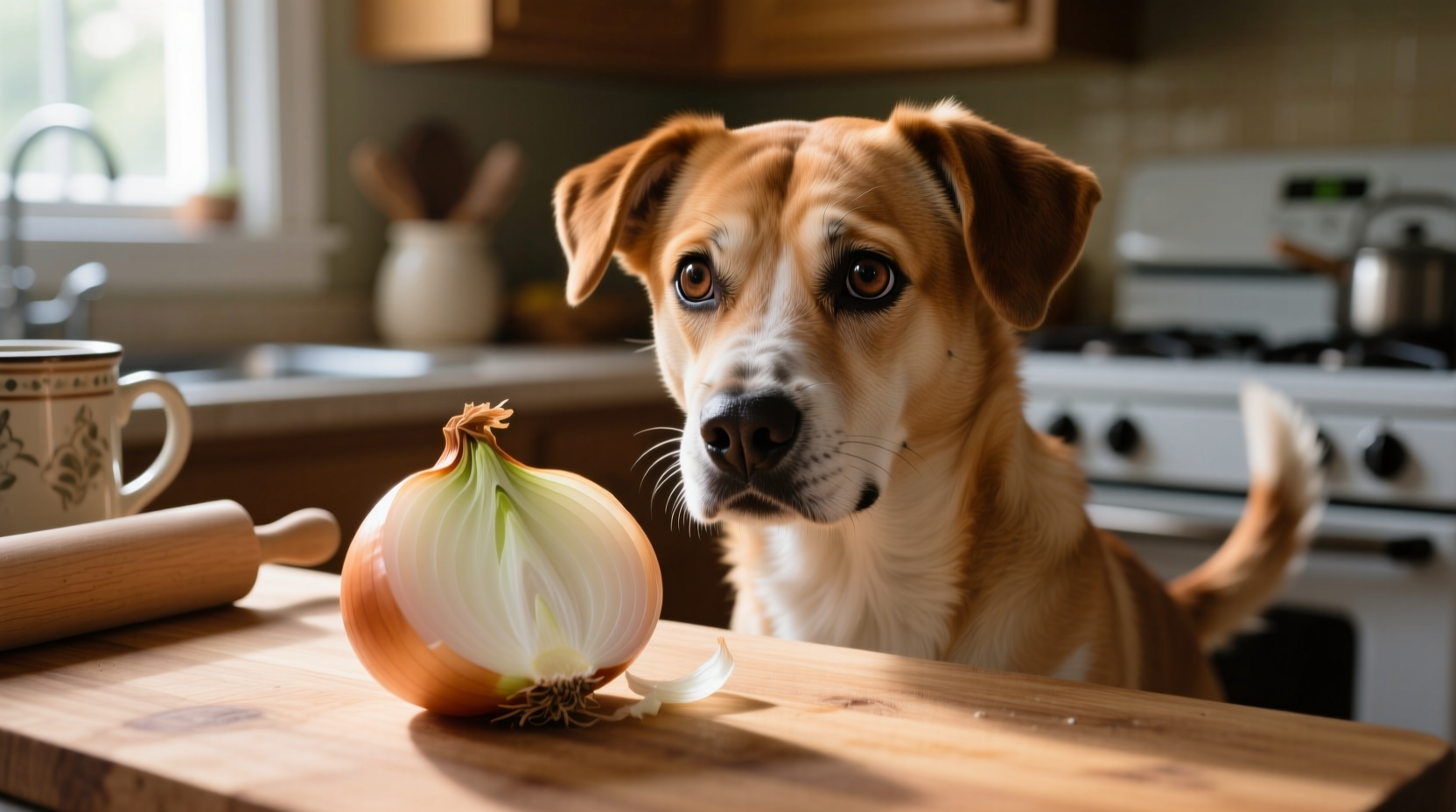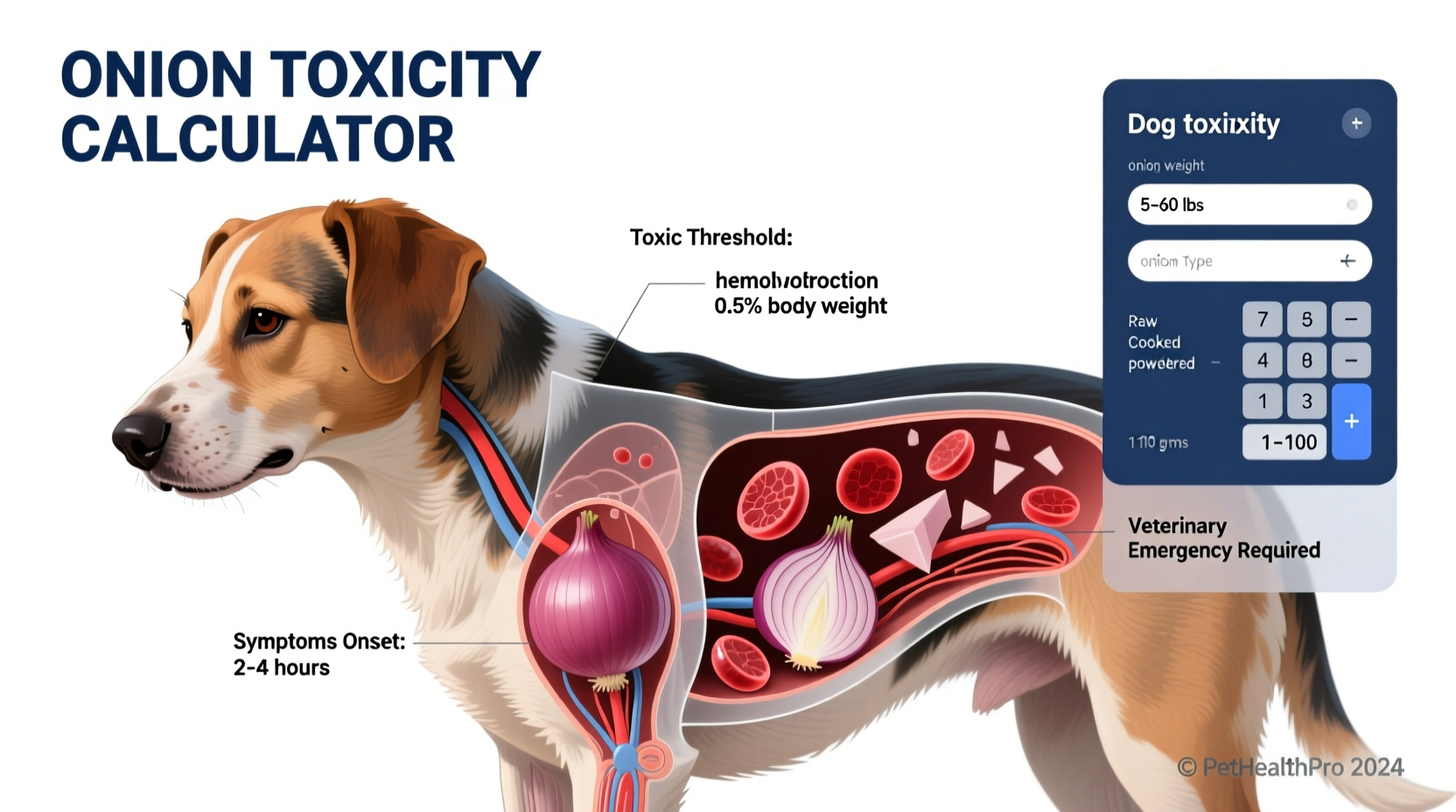Discover exactly how dangerous onions are for your dog with this science-based toxicity guide. Our dog onion toxicity calculator methodology helps you assess risk levels based on your pet's specific weight and the amount consumed. Understanding these critical thresholds could save your dog's life when every minute counts.
Why Onions Are Dangerous for Dogs: The Science Explained
Onions, garlic, and other Allium family members contain N-propyl disulfide, a compound that damages red blood cells in dogs. Unlike humans, dogs lack the enzyme necessary to process these compounds safely. When red blood cells become damaged, they rupture (hemolysis), leading to hemolytic anemia—a potentially fatal condition.
According to veterinary research published by the American Kennel Club, all forms of onions pose risks: raw, cooked, powdered, or even onion juice. The toxic principle remains active regardless of preparation method, making common kitchen ingredients unexpectedly dangerous.

Dog Onion Toxicity Calculator: Understanding the Risk Levels
While online dog onion toxicity calculators provide quick estimates, understanding the underlying methodology ensures you can assess risk accurately. The critical factor is the ratio of onion consumed to your dog's body weight.
| Dog Weight | Minimum Toxic Dose | Severe Toxicity Threshold |
|---|---|---|
| 10 lbs (4.5 kg) | 23 grams (0.8 oz) | 45 grams (1.6 oz) |
| 25 lbs (11.3 kg) | 57 grams (2 oz) | 113 grams (4 oz) |
| 50 lbs (22.7 kg) | 113 grams (4 oz) | 227 grams (8 oz) |
| 100 lbs (45.4 kg) | 227 grams (8 oz) | 454 grams (16 oz) |
This dog onion toxicity calculator chart shows that toxicity begins at approximately 0.5% of body weight, with severe effects likely at 1% or higher. For reference, a medium onion weighs about 150 grams (5.3 oz). Even small amounts in baby food or gravies can reach dangerous levels for smaller dogs.
Symptom Timeline: What to Watch For After Onion Ingestion
Understanding the progression of onion toxicity symptoms helps determine urgency. The ASPCA Animal Poison Control Center documents this typical timeline:
- 0-24 hours: Possible vomiting, diarrhea, abdominal pain (not always present)
- 24-72 hours: Lethargy, weakness, pale gums develop as anemia progresses
- 3-5 days: Dark urine (hemoglobinuria), rapid breathing, elevated heart rate
- 5+ days: Severe cases may require blood transfusions if untreated
Crucially, symptoms often appear days after ingestion, meaning your dog might seem fine initially. This delayed reaction makes immediate veterinary consultation essential even if your dog shows no immediate distress after consuming onions.
Immediate Action Plan: What to Do If Your Dog Ate Onions
Follow these critical steps if your dog consumed onions or garlic:
- Call your veterinarian immediately or contact the Pet Poison Helpline (800-213-6680) - time is critical
- Calculate the amount consumed relative to your dog's weight using the dog onion toxicity calculator guidelines above
- Do NOT induce vomiting unless specifically instructed by a professional - improper timing can cause additional damage
- Bring packaging or food sample to help veterinarians identify exact ingredients and concentrations
- Monitor for symptoms while en route to the clinic, noting any changes in behavior or physical condition
Veterinary treatment may include activated charcoal to absorb toxins, intravenous fluids, oxygen therapy, and in severe cases, blood transfusions. Early intervention significantly improves outcomes for dogs affected by onion toxicity.
Common Misconceptions About Onion Toxicity in Dogs
Several dangerous myths persist about dogs and onions. Understanding these context boundaries prevents harmful mistakes:
- Myth: Cooked onions are safe for dogs
Fact: Cooking doesn't destroy the toxic compounds - all forms remain dangerous - Myth: Small amounts in human food won't hurt
Fact: Baby food, gravies, and sauces often contain concentrated onion powder that reaches toxic levels quickly - Myth: Only raw onions are problematic
Fact: Onion powder is actually more concentrated and dangerous than fresh onions - Myth: Garlic is safe in small amounts
Fact: Garlic contains the same toxic compounds, though slightly less concentrated than onions
Preventing Onion Exposure: Practical Safety Measures
Protect your dog with these evidence-based prevention strategies:
- Store onions and garlic in closed cabinets away from curious noses
- Dispose of food scraps securely in outdoor bins with tight-fitting lids
- Read labels carefully on dog treats and foods - some contain onion powder as flavoring
- Train your dog the "leave it" command to prevent counter-surfing incidents
- Inform all household members about the dangers of sharing human food containing onions
Remember that onion toxicity represents a cumulative risk. Repeated small exposures can be as dangerous as a single large ingestion. This understanding forms the basis of accurate dog onion toxicity calculator tools used by veterinary professionals.











 浙公网安备
33010002000092号
浙公网安备
33010002000092号 浙B2-20120091-4
浙B2-20120091-4